Are Swedish meatballs actually Turkish?
After the official social media accounts of Sweden carelessly declared that Swedish meatballs really are Turkish, I wondered about the “facts” to which they referred.

The claim isn’t absurd. Did meatballs came to Sweden with the Swedish king Karl XII in the beginning of the 18th century? After losing a war against the Russians, he spent a few years in exile in the Ottoman Empire (there was no Turkey back then).
Sure, Karl XII probably enjoyed his fair share of köfte or
Let’s do look at the facts—and the sources that my wounded national pride dug up that pre-date 1709, when the king made it to Bender (and later Varnitsa) in current Moldova.
“Sticking to the facts” that are verifiable
Maybe the official Swedish social media channels have an impressive secret trump card that refuse to share.
But, what if we look at the sources available to common people like me?
How about En liten handbok i kooke-konsten, “a little guide to the art of cooking”, by Åke Rålamb, published by Bengt Höök in 1695?
The book features a recipe of fricadelles, made by chopping veal and suet, and adding mace, salt, and pepper. The balls are either put back into the sinewy layer surrounding the meat and fried, or first rolled in grated bread and egg, then boiled, then fried in butter.
Then, we have the cookbook of Christina Valleria. The exact year it was written is unknown, but research strongly suggests it was written before she married in 1708, as she references being a maid.
Valleria suggests making “oxe meat-lumps” by chopping beef and mixing it with suet, leek and eggs, seasoning it with parsely, salt, pepper, ginger and nutmeg. Add some bread crumbs and meat soup to mix it into a dough, then form “klimpar”, or lumps, and boil them in meat soup. Then, you can fry them in butter in a pan.
Valleria shares two other similar recipes, using veal, and adding mace and onion or wine to the lists of ingredients.
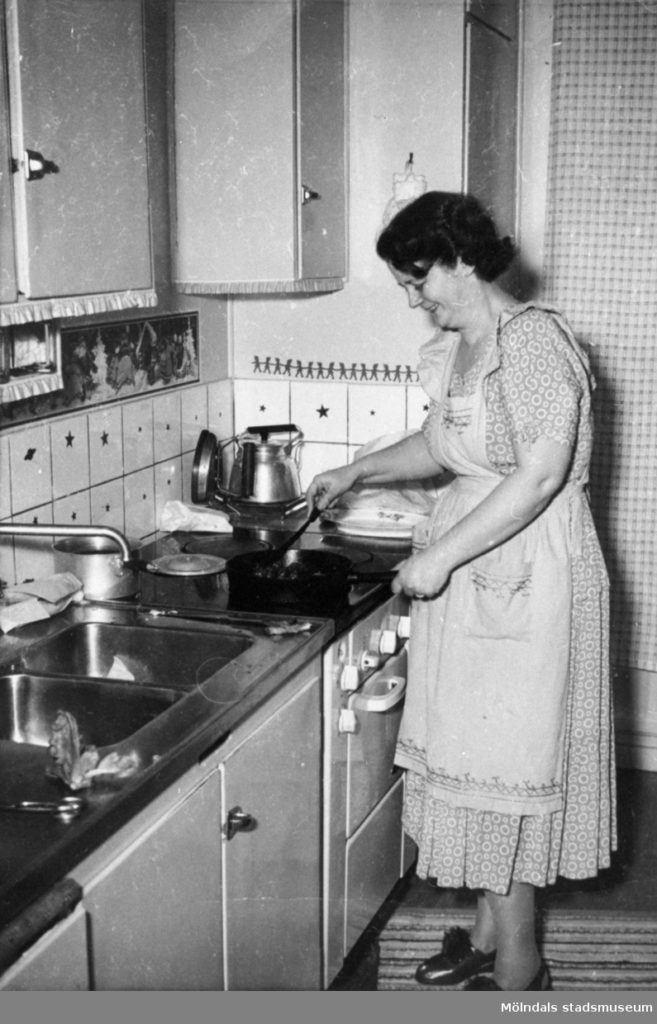
So, are they meatballs?
Yes, the recipes call them fricadelles and not meatballs. The cook boiled the poor balls before frying them in butter.
To the defense of these primeval meatballs, boiling used to be a common way of preparing food, as shown by the cookbooks of Rålamb, Valleria, and Cajsa Warg. Boiling something and putting it in a soup seems to have been very popular—even semlor were served that way. If not boiling, maybe you’d even roast something on a spit. But frying? Not very common. Still, the meatballs above were fried.
So, don’t tell me this isn’t a predecessor to the Swedish meatball.
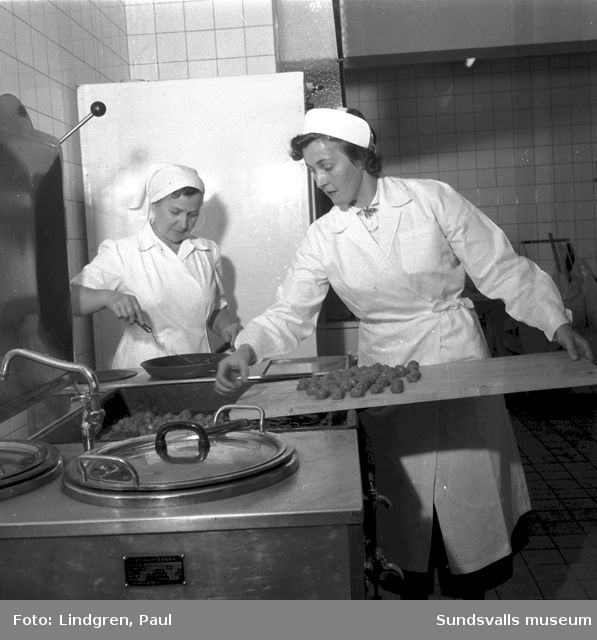
But let’s be nuanced
According to the dictionary SAOB, the word köttbulle, “fried ball of minced meat”, makes its first appearance in Cajsa Warg’s cookbook from 1755. In later editions of Warg’s cookbook, we can see a definite influence from the region of modern-day Turkey through her recipe for dolma with vine leaves.
The new influences may have come from the sixty-something creditors that followed the king back to Sweden to get their money back. Even if the creditors initially came to Karlshamn, they apparently reached Stockholm in 1719. Of course, there is a chance that either the creditors, the returning Swedish soldiers or both groups can have brought back food traditions that included meatballs.
So, do meatballs get an upswing thanks to
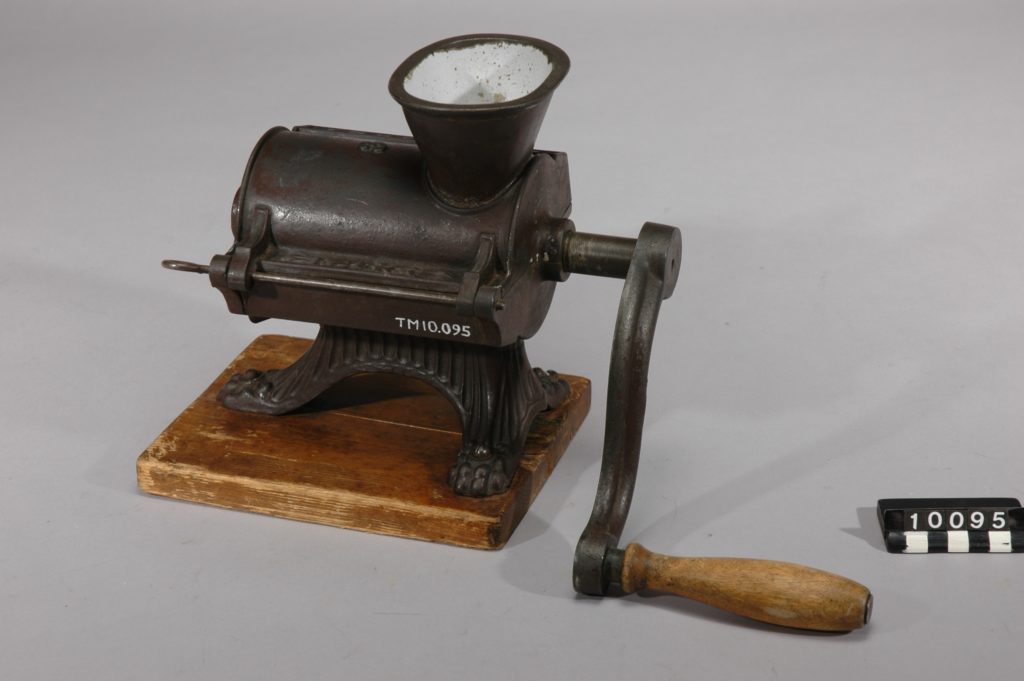
The meat grinder that changed everything
There’s an important step between the Rålamb’s, Valleria’s and Warg’s instructions for laborious meat chopping, and today’s ready-made minced meat in the shops. “The meat grinder is a new tool, which saves much time and effort, when meat is finely chopped”, Hagdahl writes. His cookbook is published for the first time in 1896. It is not an outlandish suggestion, to believe that the meatball eating increased in Sweden once it became easier to produce minced meat.
Swedish meatballs, dissected
So, some might claim that the perfect Swedish meatball only can be made by a loving mother or grandmother, and are best eaten when pilfered during cooking.
Regardless, to start off your meatball training, there are main components to consider.
The meat
This is where you can go crazy with different meats and proportions, or just use whatever you have on hand. A mixture of minced meat of beef and pork is the most common, but some use just one or the other or add lamb, veal, or moose.
Här går det givetvis att få fnatt med olika sorters kött och proportioner, eller bara använda det som råkar finnas hemma. En blandning av kött och fläsk verkar vara vanligast, men vissa recept använder bara den ena, eller använder lamm, kalv, eller vilt.
Chefs like Magnus Nilsson, Mats Öhrn, Melker Andersson, and Tareq Taylor all specify a 50-50 mix of ground beef and ground pork, while others use a higher proportion of ground beef, such as Leif Mannerström (75%), Werner Vögeli (80%) och Per Morberg (100%). Prinsessornas kokbok from 1931 suggests beef, veal, and pork, while the 1934 edition is content with skipping the veal. Tore Wretman used 50% ground beef, 25% pork, and 25% veal for his richer meatballs. The standard cookbooks are generally more vague—just use whatever ground meat you’ve got.
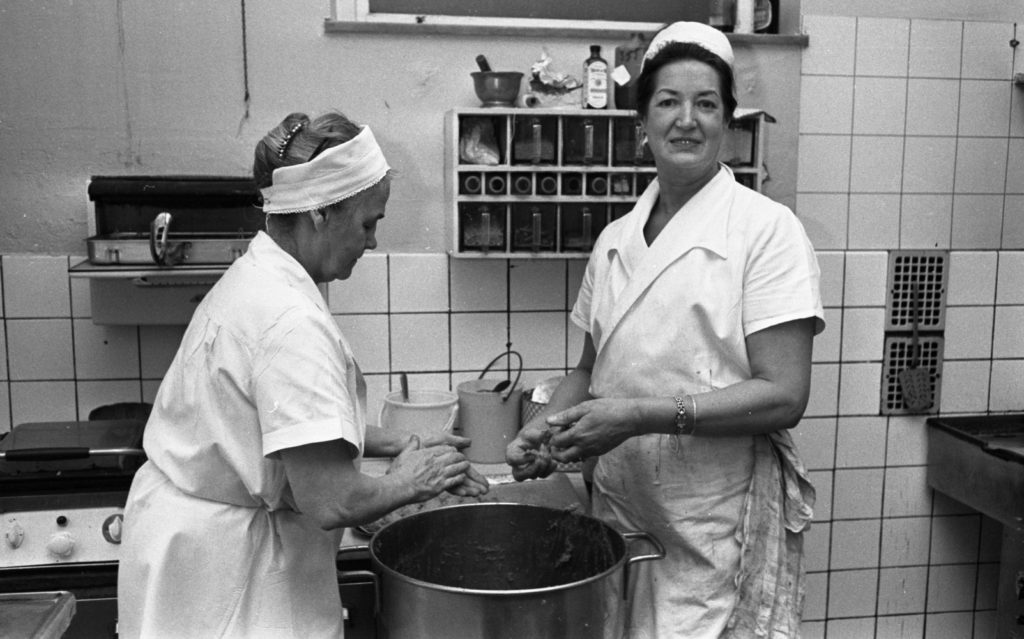
The liquid
Many recipes use some type of liquid, that also may work as a binder. While
The binder
Grated bread or breadcrumbs are the most common binders, and make the meatballs less dense. For example, we see breadcrumbs suggested in Prinsessornas kokbok. Other popular options include potato starch or mashed potato, which adds to the texture. Add too much, and the meatball will start to disintegrate.
The seasoning—traditional or crazy?
This is where things get interesting. I’ve seen suggestions for the seasoning ranging from sprats and cocoa powder to liver paté and wine, to dried trumpet chanterelles. These might not be your everyday meatballs, but often with a festive spin or made for the holidays. Mustard and allspice are two of the more common extra ingredients for everyday meatballs. You can, of course, season them however you like. In 1896, Hagdahl uses not only salt and pepper but also nutmeg, lemon, onion, capers, and sardelles to flavor his fine meatballs.
When we discuss seasoning, there’s the onion vs no onion dilemma. Some recipes, especially the older ones, skip onion entirely. If you add onion and don’t chop it finely, the protruding bits will stick to the pan and burn and make the meatballs lose their shape.
I appreciate the nutty, round flavor of onion that has been fried soft in a little butter. One recipe suggests that part of the onion can be chopped finely and fried, and the rest grated straight into the minced meat batter. The difference in taste and texture wasn’t noticeable enough that I thought the extra work was worth it.
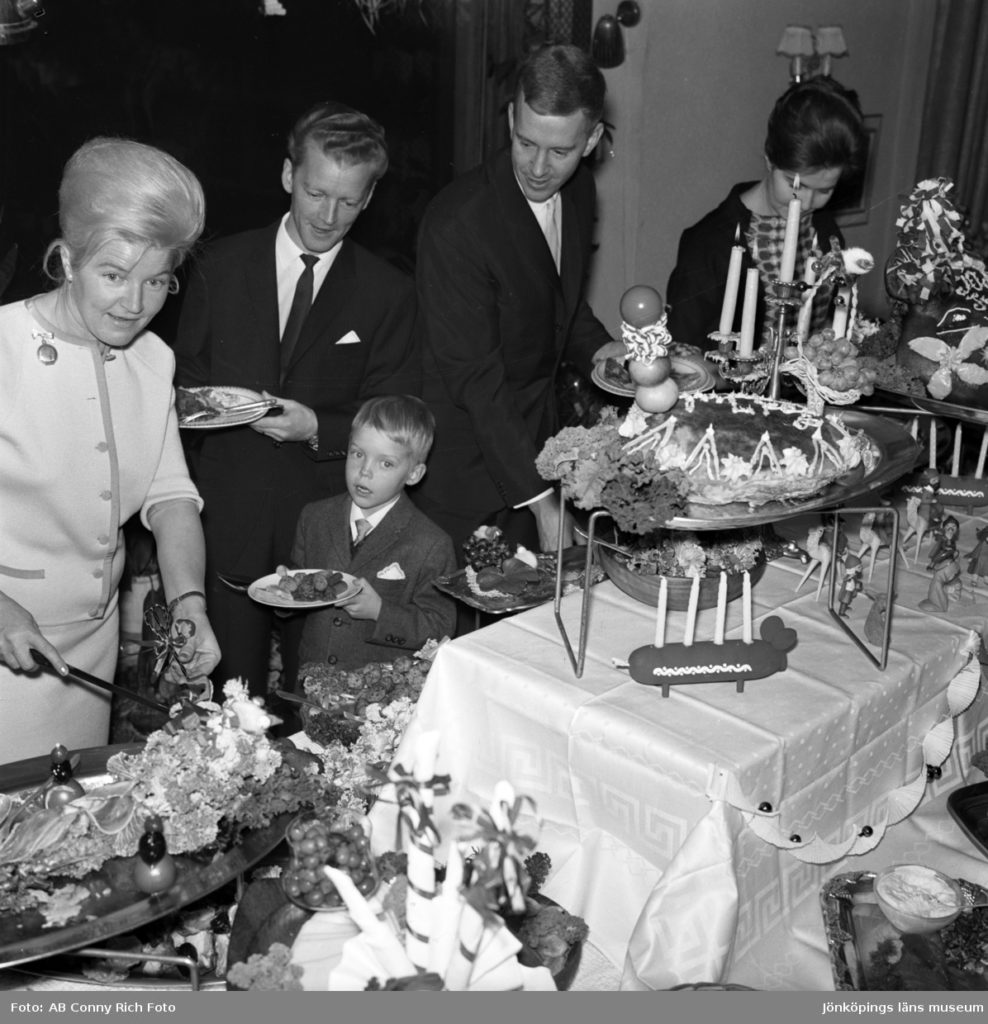
Serving Swedish meatballs
With boiled potatoes, or mashed? Milk-stewed macaroni? On a sandwich with beetroot salad? There are lots of “typically” Swedish ways to serve meatballs. While many cuisines all over the world feature their versions of meatballs, what makes the Swedish meatball Swedish might lie in the serving—with lingonberries, cream gravy, and maybe quick-pickled cucumbers.
But the meatball also has an important position on a Swedish smörgåsbord. You can tell for example by Prinsessornas kokbok from 1931, which features a special recipe called köttbullar till smörgåsbordet—”smörgåsbord meatballs”. The difference between these meatballs and the cookbook’s standard meatball recipe is that it contains less pork and more veal. It also uses cream instead of milk.
As a smörgåsbord dish, the meatball is often connected with holidays where smörgåsbord are regular—particularly, with Christmas. Christmas meatballs are more likely to be seasoned with allspice.
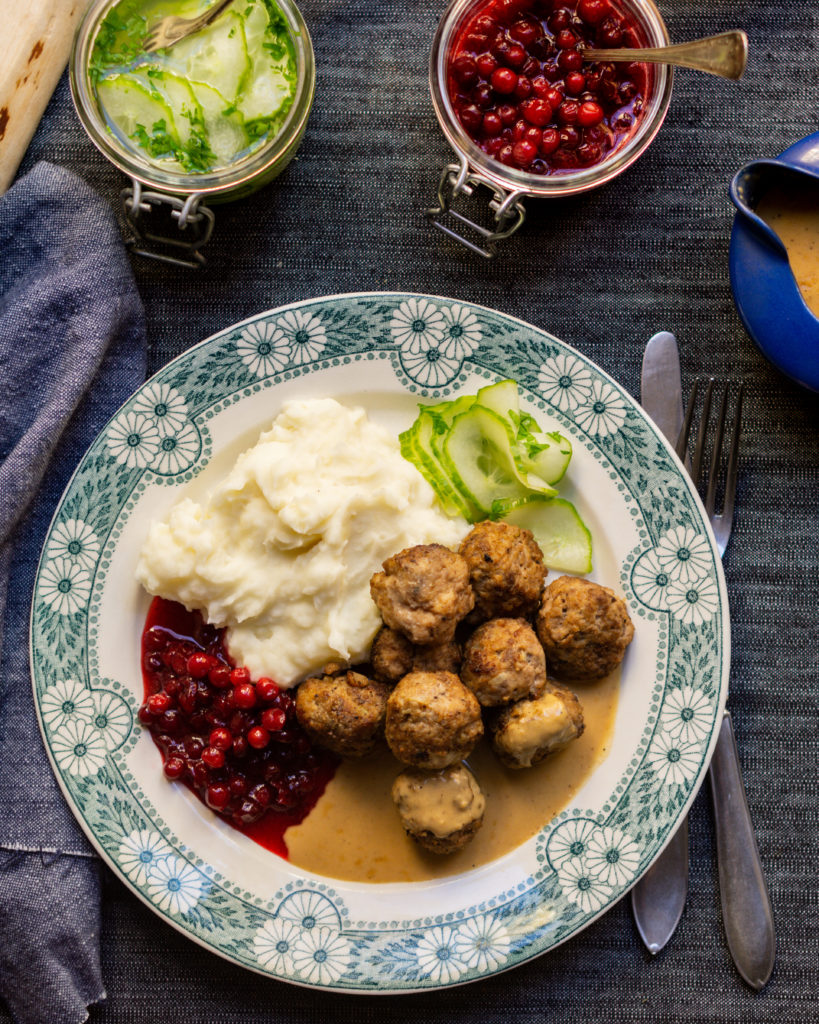
How to cook authentic Swedish meatballs
1,5 dl (3/5 cups) milk or milk mixed with cream
1,5 dl (3/5 cups) bread crumbs
1 onion
salt, pepper, maybe a small pinch of allspice
1 egg
250 gr (9oz) minced beef
250 gr (9oz) minced pork
For frying: butter or oil
For serving: boiled or mashed potato, lingonberries, cream gravy
- Mix milk, breadcrumbs and the egg in a large bowl and leave it to swell for at least 10 minutes.
- Chop the onion finely and fry it gently in butter or oil until it is soft and translucent.
- Add salt, pepper, and any other flavorings to the milk mixture and stir.
- Add the minced meat to the bowl in chunks and stir. Mix until you get a smooth batter, but don’t overdo it as the batter can become sinewy. If you can, let the batter rest for a short while before you start frying.
- Heat up some butter or oil in a saucepan. Fry a small test meatball. Taste and adjust the seasoning, if necessary.
- Wet your hands with water and roll the batter into meatballs, about the size of a walnut. Fry the meatballs in butter on medium heat. Don’t crowd the saucepan by frying too many meatballs at once, as it gives off too much liquid and makes the meatball lose the nice surface. Fry until the meatballs get some color and are cooked through.
- Serve with potatoes, lingonberries, and gravy. Or, let them cool and put in the freezer for a later date.
Cream gravy
It is difficult to give a “set” gravy recipe because I tend to make it based on what I have at home. Taste test as you go along to see what the sauce needs. If you’re starting without the meatball-y frying pan, you can just do it all in a saucepan and add a bit more beef stock concentrate or use beef stock instead of water.
2,5 dl (1 cup) water
2 tbsp flour
1 dl cream
about 1-3 tsp concentrated beef stock—to taste, depending on brand
salt, pepper
optional: dash of soy sauce, 1 tsp blackcurrant jelly or lingonberry jam
- If you can, don’t clean your frying pan after frying the meatballs and let any meatball crumbs remain in the pan.
- Mix the flour with the water until it dissolves and pour it into the pan.Bring it to a simmer.
- Add the cream and concentrated beef stock and stir. Check the taste and see if you need to add more of either—depending on how much was left in your pan from the meatballs, you may already have a good flavor. Heat it up so it is warm.
- Add salt and pepper to taste. Some people choose to add a little bit of soy sauce instead of or in addition to the salt, which adds to a darker color. If you have blackcurrant jelly or lingonberry jam at home, you can add a teaspoon or two to give extra depth of flavor.
- Strain the sauce through a sieve to remove any meatball crumbs, and the sauce is ready to serve.
Suggestions
You can of course flavor the meatballs however you like. But, don’t make the mistake of so many restaurants and add too much allspice. It is meatballs, not glögg-balls.

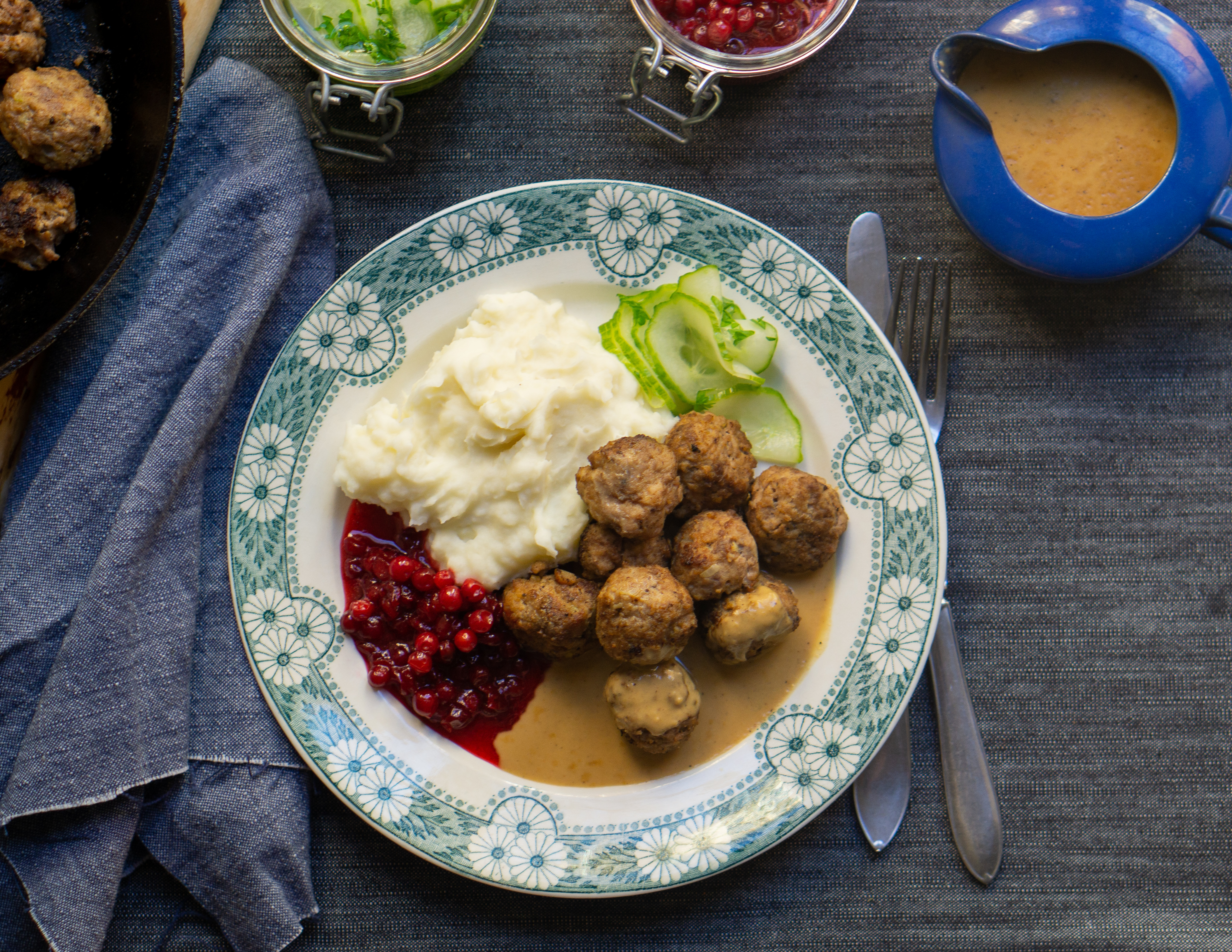

Is there a recipe for the cream gravy?
Hi Ellie, I’ve added a cream gravy recipe based on how I normally do it. Experiment with the proportions and the flavors to get it just right for you!
Thank you!
Hej
I wanted to bring to your attention that 250 g is 8.8 ounces, not 1 lb. Imperial measurements can be confusing especially the using of ounces for both weights and liquid measurements. Love your recipes/blog.
Patrick, thank you so much for your comment! For some reason, it ended up in spam (where it definitely didn’t belong). It’s still a bit tricky for me to convert recipes, so I really appreciate your input and have made adjustments.
Hi! Is there any harm in using beef stock in place of water for the gravy, even if I am making it in the meatball pan after frying? Then maybe I don’t have to worry about the concentrated beef stock you’ve included in the recipe? Thanks!
Hi Gunilla, using beef stock sounds like an excellent idea! The main thing is to give the sauce a good amount of flavor, but there’s no one “true” recipe for gravy — often, people just add a little cream or milk to the pan, add some flour and then strain it all before serving.
Also, how many servings does this recipe make? Thank you!
I’d count on the proportions being enough for four people as a main course.